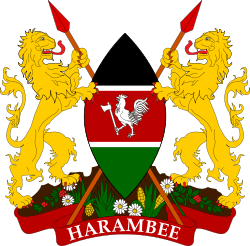Coat of arms of Kenya
| Coat of arms of Kenya | |
|---|---|
 | |
| Details | |
| Armiger | Republic of Kenya |
| Adopted | 1963 |
| Escutcheon | On a maasai shield per fess Sable and Vert, on a fess Gules fimbriated Argent a cock grasping in the dexter foot an axe of the same |
| Supporters | On either side a lion Or armed and langued Gules, grasping in the interior forepaw a spear of estate Proper, the shafts of the spears gules crossing in saltire behind the shield |
| Compartment | The whole upon a compartment representing Mount Kenya proper containing in the foreground examples of Kenya agricultural produce – coffee, pyrethrum, sisal, tea, maize and pineapples. The scroll which was color brown containing the National Motto |
| Motto |
Harambee (Let's pull together in Swahili) |
| Coat of arms of Kenya on reverse of 10 cent Kenyan coin. | |
|---|---|
.jpg) | |
| Obverse: Mzee Jomo Kenyatta. The First President of Kenya. | Reverse: Coat of arms of Kenya, year of minting, face value and Harambee. |
| Total 120,700,515 coins minted from 1969 to 1978. | |
The coat of arms of Kenya features two lions, a symbol of protection, holding spears and a traditional East African shield. The shield and spears symbolize unity and defence of freedom. The shield contains the national colours, representing:[1]
- Black for the people of Kenya
- Green for the agriculture and natural resources
- Red for the struggle for freedom
- White for unity and peace.
Rooster holding an axe - According to the African tradition, the rooster is the only domestic fowl that announces the dawn of a new day, much like the wake up call of an alarm clock. That's why roosters are kept. At the rooster's crow, everyone wakes up and begins work before the dawn. The rooster is also one of the few animals that seldom moves backwards. The rooster holding an axe while moving forward portrays authority, the will to work, success, and the break of a new dawn. It is also the symbol of Kenya Africa National Union (KANU) party that led the country to independence.
The shield and lions stand on a silhouette of Mount Kenya containing in the foreground examples of Kenya agricultural produce - coffee, pyrethrum, sisal, tea, maize and pineapples.
The coat of arms is supported by a scroll upon which is written the word 'Harambee'. In Swahili, Harambee means "pulling together" or "all for one". It is the cry of the fishermen as they draw their nets towards the shore. The same word is echoed by everyone when a collective effort is made for the common good, such as helping a family in need, or the construction of a school or a church.
Description
The shield contains the national colours: black, green and red. The middle red strip bears a cockerel holding an axe. The supporters of the shield are two Kenya lions, resting on a background silhouette of Mount Kenya containing in the foreground examples of Kenya agricultural produce – coffee, pyrethrum, sisal, tea, maize and pineapples. The scroll containing the National Motto "Harambee" (literally means "all pull together" in Swahili).
Blazon
On a maasai shield per fess Sable and Vert, on a fess Gules fimbriated Argent a cock grasping in the dexter foot an axe of the same. Supporters: On either side a lion Or armed and langued Gules, grasping in the interior forepaw a spear of estate Proper, the shafts of the spears gules crossing in saltire behind the shield. The whole upon a compartment representing Mount Kenya proper containing in the foreground examples of Kenya agricultural produce – coffee, pyrethrum, sisal, tea, maize and pineapples. The scroll which was color brown containing the National Motto: "Harambee" (literally means "all pull together" in Swahili).
See also
References
- ↑ Kenya National Archives. "Kenya Armorial Ensigns". Archived from the original on 2006-06-10. Retrieved 2008-07-31.